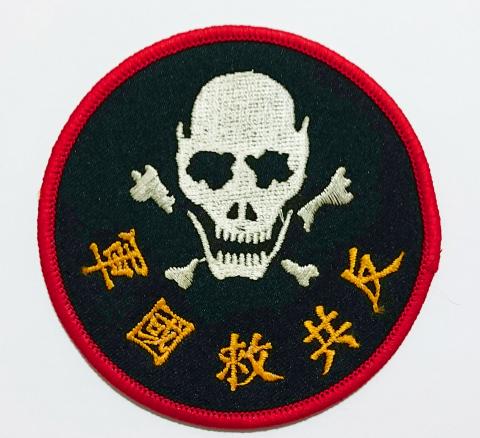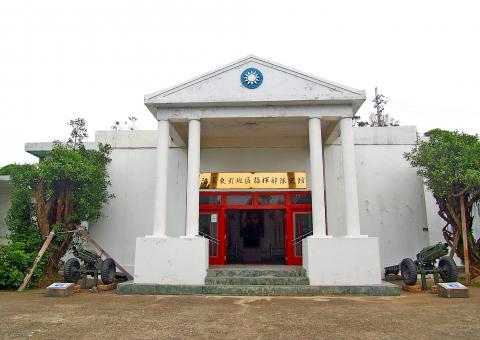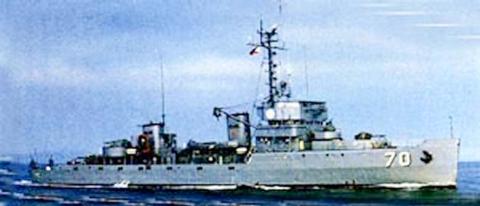Nov. 18 to Nov. 24
Fan Chen (樊鎮), a “model revolutionary soldier deeply influenced by the Three Principles of the People” and a captain in the Anti-Communist Advance Army (反共挺進軍), successfully landed in China’s Zhejiang Province with 11 subordinates on June 27, 1963.
When ambushed by People’s Liberation Army troops en route to the “target area,” Fan stayed behind to hold off the enemy so his comrades could go on, “achieving his vow to give his life for the mission.”

Photo courtesy of the Dongyin Anti-Communist National Salvation Army Veterans Association
Fan was one of 21 “anti-communist martyrs” (反共烈士) honored on the front page of the Central Daily News (中央日報) on Nov. 23, 1964, all losing their lives in similar situations after infiltrating different areas along the coast of Communist-ruled China between 1950 and 1963. They were either members of the Anti-Communist Advance Army, the Anti-Communist National Salvation Army (反共救國軍) or agents who were already behind enemy lines.
According to the report, these martyrs were tasked with supporting the “holy war against the communists” by “planting seeds and lighting fires” in China. “They have not only caused the illegitimate regime to panic, but have also garnered much international attention.”
“They have established bases across China and have linked up with local anti-communist forces, greatly expanding the anti-communist presence in China,” the report states, adding that there were countless more who gave their life for the cause.

Photo courtesy of National Central Library
INFILTRATING CHINA
Republic of China (ROC) military groups had been operating off the coast of China since the Chinese Nationalist Party (KMT) retreated to Taiwan in 1949, continuing to clash with the communists throughout the decades. They received significant US support, especially after the Korean War broke out in 1950. In 1960, the different brigades were reorganized into a singular Anti-Communist National Salvation Army based at Dongyin (東引), one of the Matsu Islands off the Chinese coast.
Profiles of the featured martyrs provide a glimpse of the anti-communist activities since the end of the Chinese Civil War. In 1949, Fujian native Pan Hao-hsing (潘皓興) fled to the hills and engaged in guerilla resistance against the People’s Liberation Army; he officially joined the KMT resistance in 1950 and served as one of its contact points within China. He died trying to rescue a comrade that December.

Photo courtesy of Wikimedia Commons
Han Wen-chu (韓問渠), the only female on the list, became a secret agent for the KMT in Jiangsu Province in 1953 to avenge her husband. She was captured, interrogated and killed.
By 1954, the KMT still ran the Zhejiang Provincial Government from Dachen Island (大陳), where a branch of the Anti-Communist National Salvation Army was stationed. Zhejiang native Wang Yi-tsai (王義才) had retreated to Taiwan with the KMT, but in 1954 he headed to Dachen with plans to infiltrate China. When the People’s Liberation Army (PLA) overran Dachen in February 1955, Wang pretended to be a KMT hostage and joined the PLA as a spy. He was executed when he blew his cover. Liang Chu-cheng (梁居正) had the most illustrious career on the list, completing five missions into enemy territory between 1953 and 1958. He was caught on the sixth and executed.
A 1965 Taiwan Review article details the activity of the army, noting that that before 1962, “the emphasis was on information gathering and the planning of underground organizations. Now, the information is being used and the plans are being carried out. Many groups of commandos have conducted probing attacks along the mainland coastline during the last two years.”

Photo courtesy of Wikimedia Commons
The Central Daily News article also mentions this increased activity, noting that between March 1962 and November 1963, 56 brigades consisting of 1,785 soldiers had successfully conducted operations in China. “Five provinces along the coast and strategic inland locations have felt the blows of guerrilla and commando bands,”the Taiwan Today article states.
The article speaks glowingly about the successes of these operations, pays respect to a few failures and concludes that “they are the vanguard of the struggle for a free and peaceful China, and of a victory that must be won before the Chinese Communists can spread nuclear devastation across the earth.”
THE GUOGUANG PROJECT
The intensifying military activity in 1963 is likely tied to the Guoguang Project (國光計畫), initiated in 1961 to take advantage of China’s disastrous Great Leap Forward and launch a full-scale invasion.
The plan appears to be highly unrealistic. Admiral Wang Ho-su (王河肅) recalls in an oral history book published by the Ministry of National Defense that they were to launch a surprise attack on Xiamen and quickly establish a base, cut off the railroad and then either invade Guangdong or Fujian from there. So much of the plan’s success depended on external factors, including US military aid, the anti-communist sentiments of the Chinese as well as the questionable loyalty of the former KMT troops who had been stranded in China for over a decade.
The US predictably was not supportive, and meanwhile, China successfully tested its first nuclear weapon in October 1964. Chiang reportedly was adamant on the invasion, stating: “There is no way that we will wait for American permission!” Judging from the various accounts in the oral history book, nobody dared to speak out against Chiang.
On June 17, 1965, Chiang made a dramatic pep talk to the officers at the ROC Military Academy, noting that the “counterattack on the mainland” would soon begin and that they should write their wills in advance.
Things did not go smoothly at all. A landing drill on June 24, 1965 ended up in disaster, when strong waves overturned five amphibious assault vehicles, causing over 10 deaths. On Aug. 6, two warships set out to transport agents to China for advance scouting, but the PLA had already caught wind of the mission. It dispatched a torpedo fleet that intercepted the warships at sea, sinking both and killing around 200 troops. Admiral Hsu Hsueh-hai (徐學海) recalls that the ROC Air Force was not informed of this mission due to a communication error, and its reinforcements arrived too late.
“The failure of this challenging mission directly affected [Chiang’s] confidence and determination. He was already very old and sick, and there was nobody who could replace him as a top decision maker. So the plan to retake China was shelved,” recalls General Chu Yuan-tsung (朱元琮).
Taiwan in Time, a column about Taiwan’s history that is published every Sunday, spotlights important or interesting events around the nation that have anniversaries this week.

A vaccine to fight dementia? It turns out there may already be one — shots that prevent painful shingles also appear to protect aging brains. A new study found shingles vaccination cut older adults’ risk of developing dementia over the next seven years by 20 percent. The research, published Wednesday in the journal Nature, is part of growing understanding about how many factors influence brain health as we age — and what we can do about it. “It’s a very robust finding,” said lead researcher Pascal Geldsetzer of Stanford University. And “women seem to benefit more,” important as they’re at higher risk of

March 31 to April 6 On May 13, 1950, National Taiwan University Hospital otolaryngologist Su You-peng (蘇友鵬) was summoned to the director’s office. He thought someone had complained about him practicing the violin at night, but when he entered the room, he knew something was terribly wrong. He saw several burly men who appeared to be government secret agents, and three other resident doctors: internist Hsu Chiang (許強), dermatologist Hu Pao-chen (胡寶珍) and ophthalmologist Hu Hsin-lin (胡鑫麟). They were handcuffed, herded onto two jeeps and taken to the Secrecy Bureau (保密局) for questioning. Su was still in his doctor’s robes at

Last week the Democratic Progressive Party (DPP) said that the budget cuts voted for by the China-aligned parties in the legislature, are intended to force the DPP to hike electricity rates. The public would then blame it for the rate hike. It’s fairly clear that the first part of that is correct. Slashing the budget of state-run Taiwan Power Co (Taipower, 台電) is a move intended to cause discontent with the DPP when electricity rates go up. Taipower’s debt, NT$422.9 billion (US$12.78 billion), is one of the numerous permanent crises created by the nation’s construction-industrial state and the developmentalist mentality it

Experts say that the devastating earthquake in Myanmar on Friday was likely the strongest to hit the country in decades, with disaster modeling suggesting thousands could be dead. Automatic assessments from the US Geological Survey (USGS) said the shallow 7.7-magnitude quake northwest of the central Myanmar city of Sagaing triggered a red alert for shaking-related fatalities and economic losses. “High casualties and extensive damage are probable and the disaster is likely widespread,” it said, locating the epicentre near the central Myanmar city of Mandalay, home to more than a million people. Myanmar’s ruling junta said on Saturday morning that the number killed had